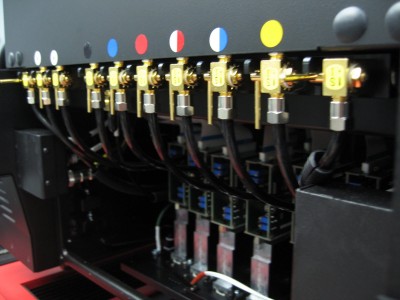Preventing problems
Personal protective equipment (PPE) and good work practices can minimize direct skin and eye contact with UV-curable materials to keep signmakers safe and healthy.
Safety glasses
When mixing or pouring UV-curable materials, there is a chance of ink splashing back into the eyes. Whenever this risk exists, it is important to wear safety glasses.
In screenprinting shops, for example, glasses should be worn whenever working on the underside of a screen or press, as ink could drip or splash toward the eyes. The same is true when pouring inks into bulk delivery systems for inkjet printers.
Protective gloves and clothing
Protective gloves and clothing should be worn based on the tasks at hand. In screenprinting, for example, when mixing or pouring ink, carrying it to the press or cleaning the screens and squeegees, there can be direct contact with UV-curable materials. The same is true in digital printing when emptying waste ink reservoirs, cleaning printheads and setting up machines.
Nitrile or neoprene gloves that are impervious to these materials are recommended to eliminate the chance of contact with the hands, along with a nitrile or neoprene apron when mixing inks. Long sleeves and pants should fit closely to the body, to protect against direct contact without risking getting caught in equipment. Gloves and clothing containing latex should be avoided, as many people are allergic to it.
Some technicians wear flashspun high-density polyethylene fibre arm gauntlets and coveralls when they carry ink cans to presses, protecting their arms and legs in case any UV-curable materials rub off. This clothing is also recommended for workers who empty trash bins containing substrates with wet (i.e. uncured) UV materials.
Some people like to use ‘barrier creams,’ which form a protective layer between the skin and outside contaminants. These should be used in conjunction with protective gloves and clothing, never by themselves.

In screenprinting, it is important to wear protective gloves and clothing when cleaning the screens and squeegees, as there could be direct contact with UV-curable materials.
Safety glasses, gloves and protective clothing are needed when cleaning up a spill of uncured UV materials—along with protective shoe coverings, if the cleaning necessitates stepping into the spill. Any objects contaminated by the spill should be placed in a bag or container, so no one else comes into contact with them, either.
Respiratory protection
UV materials have a distinctive odour, even at room temperature, but this odour by itself does not indicate a hazard. Since there is no solvent, there is no evaporation, so the components of ink do not become airborne.
During printing, for example, a strong odour will be noticed when the photoinitiator is hit with UV light and begins the curing process. This odour is not hazardous, though some people find it unpleasant. Most of it should be sent away from the substrate through an exhaust system, along with the ozone and heat from the UV lamp.
No respiratory protection is required when using these materials, but if their odour becomes bothersome, it may be worth checking the exhaust system on the press.
Disposal considerations
As is the case with all inks, waste UV materials should never be disposed of down the drain. They should be collected and then managed off-site by a licensed waste handler, keeping them separate from solvent inks, cleaning solvents and other waste.
Other practices
In combination with PPE, good work practices to protect against exposure to UV materials include the following:
- Keeping work areas tidy, clean and free of all traces of UV materials.
- Keeping all surfaces wiped clean, since UV materials left upon them will not evaporate or cure over time.
- Storing contaminated shop towels in closed bins, not on the press or in a pocket.
- Washing hands after every task where they are exposed to UV materials, even when gloved.
- Never eating or drinking near UV materials.






